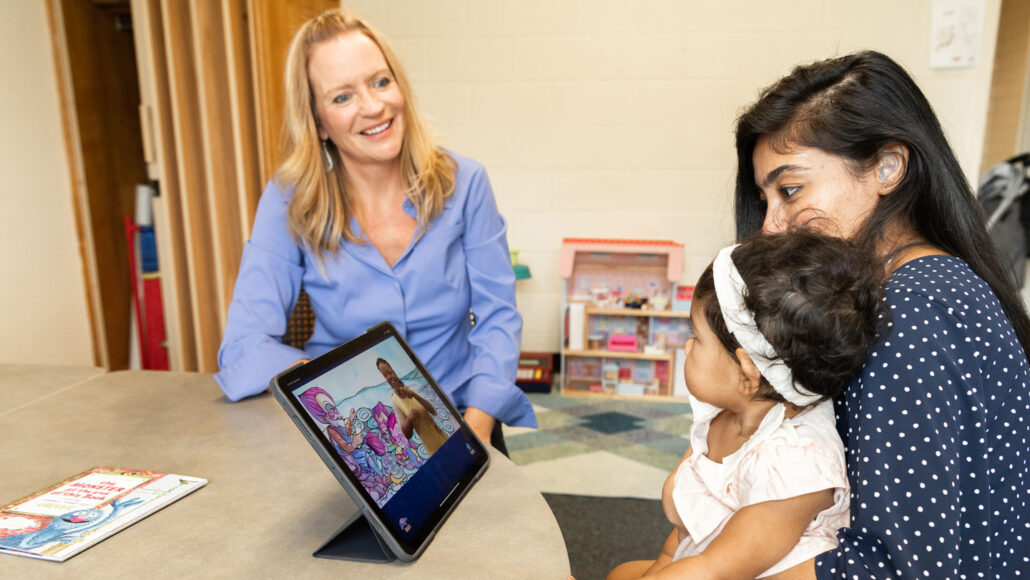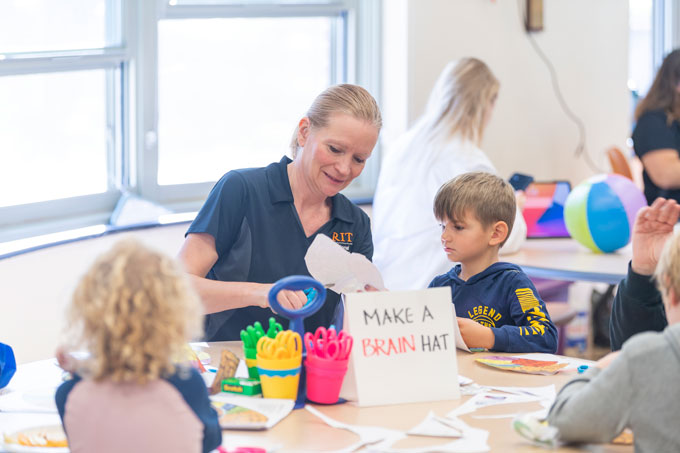Rain Bosworth studies how deaf kids experience the world
The deaf psychologist has found that babies are born ready to learn sign language

Work by deaf experimental psychologist Rain Bosworth (left) suggests that babies have an innate sensitivity to sign language.
Mike Guinto
By Meghan Rosen
In a darkened room in Rochester, N.Y., a baby girl in a pink onesie watches a computer screen. Wherever she looks, an eye tracker follows. It records what she looks at and for how long.
The baby, about 6 months old, is neither deaf nor hard of hearing. And she’s never seen any kind of sign language before. But somehow, she and others her age can tell the difference between gestures and formal signs. When a woman onscreen uses American Sign Language, these young babies usually stare at her hands. When she makes non-sign gestures, babies often look at her face or look away.
“I thought it was pretty remarkable,” says experimental psychologist Rain Bosworth. She works at the Rochester Institute of Technology (RIT). In 2022, she and her team shared these findings in Frontiers in Psychology. Their work suggests that babies are born with the ability to notice sign language and ready to learn any language, spoken or signed.
That idea can be hard to believe, she says. After all, we live in a hearing-centric world.
“There is a bias to think of spoken language as somehow superior to signed language.” But that’s just not true, she says. “Sign language is a full and real language, just as powerful as English.”
Bosworth investigates how people learn and process sign language. She studies how both deaf and hearing people use vision and touch. With this and other research, she tries to understand how early experiences shape the ways kids grow and learn. She might ask, for example, what happens if a kid sees their parents using sign language, or hears technical, scientific terms at home. Will that change how the child develops?
In 2022, Bosworth established a new research lab at RIT’s National Technical Institute for the Deaf (NTID). She named it PLAY Lab (for Perception, Language and Attention in Youth). She’s passionate about changing negative perceptions of sign language and deaf people. Deaf herself, Bosworth feels she’s the right person to come up with study questions. She tells me this via interpreters on Zoom. “I think about science nonstop, 24/7.”
Bosworth’s career shows how determined she is, says Karen Emmorey. Emmorey is a cognitive neuroscientist. She works at San Diego State University in California. Deaf researchers can face challenges hearing people may never consider. For example, they often need to arrange interpreters for lectures, meetings, social events — and interviews. But Bosworth is stubborn, Emmorey says. “She’s going to persevere and do what she needs to do to succeed.”
The window for language learning
More than nine in every 10 deaf kids in the United States have parents who can hear. Even today, Bosworth says, it’s not uncommon for physicians and other professionals (such as audiologists) to advise these parents to avoid sign language. Instead, kids are encouraged to get cochlear (KO-klee-ur) implants and to learn to read lips.
There’s this incorrect thought that sign language will impair speech development, Bosworth says. Yet recent evidence, she says, suggests that learning sign language may actually boost a child’s spoken vocabulary.
Bosworth was born in San Francisco, Calif., to hearing parents. She grew up in Los Angeles, Calif. Her school did not allow sign language. Her first brush with it came on the school bus, when she was 6 or 7 years old. She and other deaf kids made up their own signs to communicate. That cracked the door to a rich new world of visual language.
A friend she later met in high school kicked that door wide open. Bosworth’s friend was deaf and so were her parents and siblings. “I was like, ‘This is the best thing I’ve ever seen,’” she remembers thinking.

She sees reminders of that experience in students who come for the first time to the National Technical Institute for the Deaf. It serves more than 1,100 deaf and hard-of-hearing students. Students, faculty and staff there use sign language in classrooms, laboratories and public spaces. Before arriving, many kids had been the only deaf people in their schools, Bosworth says. They often struggled with feeling alone or left out. They faced many barriers to learning.
Now, “they’re definitely on cloud nine,” she says, describing their feelings of happiness and excitement. “This is like a second home to them.”
It’s a second home for Bosworth too. At NTID, she can unspool her curiosity and let it fly. Bosworth is proud to help create a sense of inclusion. “I’m able to be a role model to all of these students of what a deaf person can do.”
Early exposure to signing helps
Bosworth’s research is filling in a more complete picture of how deaf and hearing kids acquire language, says linguist Jenny Singleton. At Stony Brook University in New York, she studies how people learn sign language. Bosworth found that language learning changes as children grow and take in new information. For instance, non-signing babies who can hear tend to lose their innate ability to tell the difference between signs and gestures. This happens at around one year old. Her team has also found that these older babies no longer pay special attention to certain types of fingerspelled words.
Both results suggest that the window for learning sign language closes somewhat with age. This is similar to spoken languages.
While still a graduate student at the University of California, San Diego, Bosworth examined the visual abilities of deaf adults. Now, she combines the study of linguistics and visual perception “in a really impressive way,” Singleton says.
Bosworth also is investigating how kids explore the world and how they play. How does a child’s background and hearing status influence their behaviors? Do deaf kids rely on their sense of touch more than hearing kids do? Do specific types of play affect how children learn language?
A need for more deaf role models
For Bosworth, it’s not enough to make scientific strides in a field dominated by hearing people. She wants to bring deaf people along and mentor kids. “I want them to get on this research bus with me,” she says.
Over time, she hopes for more deaf role models at universities. She also wants to see more research that casts deaf people in a positive light. Her research already highlights their strengths rather than looking for shortcomings.
Savannah Tellander is a graduate student in Bosworth’s lab. She is hard of hearing. In grade school, she sometimes felt as if teachers assumed she wasn’t as smart as other kids. “They would usually doubt me before they ever met me,” she says. Those kinds of experiences are part of what drew her to Bosworth’s lab.
Do you have a science question? We can help!
Submit your question here, and we might answer it an upcoming issue of Science News Explores
Like Bosworth, Tellander wants to teach people how to support deaf kids’ thought processes and language. And she was impressed from the get-go with Bosworth’s zest for mentoring.
Tellander remembers first meeting Bosworth at NTID. She’d just moved from California. She had no friends or family nearby. Bosworth’s eyes lit up talking about her own experiences with her adviser. “She was really, really excited to be a mentor,” Tellander recalls.
On any given day, she says, you may find Bosworth helping students write a research proposal, teaching them how to make a poster of their results or finding time outside of work to attend a friend’s art show.
It’s important to Bosworth that deaf students know that they have their own strengths. Despite what the world may be telling them, they can lead successful lives. “I see deafness as a life experience that shapes who we are just like any other cultural experience,” Bosworth says. “I think that being deaf is wonderful.”







